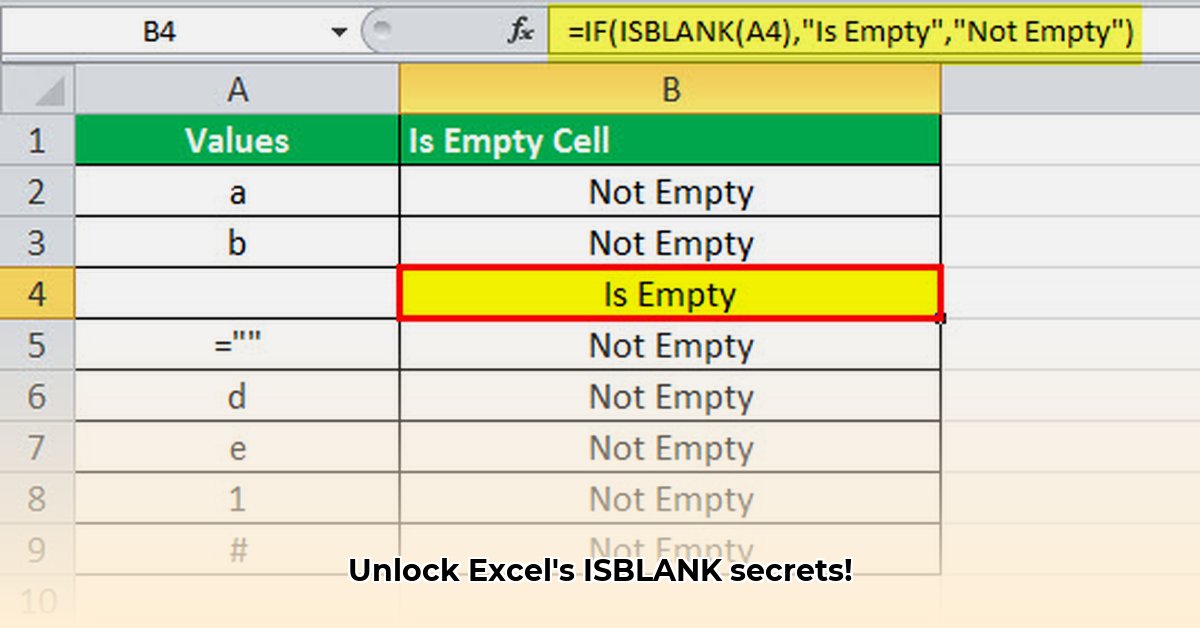
Ever wished for an easy way to identify empty cells in your Excel spreadsheets? This guide unveils the power of the ISBLANK function, progressing from basic usage to advanced techniques that will make you a spreadsheet expert. We'll cover practical applications, troubleshoot common issues, and explore solutions for both beginners and seasoned Excel users.
Understanding the ISBLANK Function's Core Functionality
The ISBLANK function (a simple yet powerful tool) checks if a cell is empty. If a cell is truly empty, ISBLANK returns TRUE; otherwise, it returns FALSE. This seemingly basic capability is the foundation for a surprisingly wide range of applications. Remember, even a single space within a cell will result in a FALSE return.
Beyond the Basics: Advanced Applications of ISBLANK
While identifying empty cells is useful on its own, the true power of ISBLANK emerges when combined with other Excel functions. Let's explore some advanced uses:
Conditional Formatting: Visualizing Empty Cells
Effortlessly highlight empty cells using ISBLANK within a conditional formatting rule. This instantly improves data readability, making it significantly easier to spot missing data. Select your range, go to Conditional Formatting, and create a new rule based on a formula like =ISBLANK(A1).
Data Validation: Ensuring Data Integrity
Prevent incomplete data entry with ISBLANK and Excel's data validation. This ensures your spreadsheets maintain data quality, especially crucial for collaborative projects. Set up data validation rules to highlight or reject entries with missing information.
Dynamic Data Filtering: Isolating Specific Data
Combine ISBLANK with the FILTER function to efficiently pinpoint and isolate rows with missing values in specific columns. This streamlined process greatly simplifies data cleanup, particularly beneficial for large datasets.
Robust Formula Creation: Error Prevention
ISBLANK is invaluable in complex formulas, preventing errors like #DIV/0!. By checking for empty cells before performing calculations, you'll make your formulas more robust and reliable. For example, =IF(ISBLANK(A1),0,B1/A1) prevents division by zero errors.
Navigating the Nuances: Handling Empty Strings and Spaces
ISBLANK has subtle behaviors to understand: It doesn't treat cells containing only spaces as truly empty. Moreover, formulas returning an empty string ("")—visually blank—are also marked as not blank.
To reliably identify empty cells, consider this approach: Combine ISBLANK with the LEN function (which counts characters). If LEN(A1) returns 0, then the cell is truly empty.
Advanced Techniques: Array Formulas and VBA
For power users, combine ISBLANK with array formulas to check multiple cells simultaneously, boosting efficiency for large datasets. Furthermore, integrating ISBLANK within VBA macros opens the door to automation and custom solutions tailored to your specific workflow needs.
Real-World Example: Cleaning Customer Data
Imagine a customer database with occasional missing addresses. Use ISBLANK to create a helper column identifying these missing entries:
- Add a Helper Column: Insert a column next to your address column.
- Formula: Enter
=IF(ISBLANK(A2),"Missing Address","Address Present")in the first cell of the new column and copy down. - Filter: Use Excel's filter to display only rows with "Missing Address".
This instantly isolates records requiring attention, streamlining the cleaning process. Isn't that clever and efficient?
A Comparative Overview: Weighing the Pros and Cons
ISBLANK offers many advantages, but understanding its limitations ensures successful implementation.
| Advantages | Disadvantages |
|---|---|
| Simple syntax, easy to understand | Doesn't distinguish between truly empty cells and those with spaces |
| Works well with other functions | May give unexpected results when cells contain formulas returning "" (empty strings) |
| Essential for data validation and cleanup | Requires additional steps for reliable blank cell identification in complex scenarios |
| Improves data quality and efficiency | Limitations need to be addressed during the design of complex spreadsheet logic |
Conclusion: Mastering ISBLANK for Enhanced Data Management
Mastering the ISBLANK function is crucial for efficient data analysis in Excel. By understanding its capabilities and limitations, you'll create more robust and reliable spreadsheets paving the way for superior data management. Remember to leverage the advanced techniques discussed to take your spreadsheet skills to the next level. This ensures smoother, more effective data analysis.